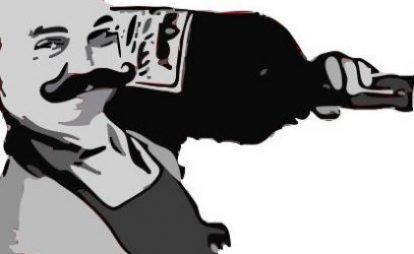Now that I’ve scrubbed my hands almost clean again after some harvest action, it is pouring down and we leave things to the able hands to the guys in the cellar. Last week wasn’t all about my harvest experience though, no, there is much more going on in the world of wine and you’ll read about it in the latest edition of the JollyCellarMaster Weekly:
Help from the Crowd, Ventilation and Organic Viticulture
First, though apologies for showing off my Lagrein-stained hands. I was warned to wear gloves during harvest if I didn’t want to run around with dirty hands for days, but part of the fun is to tell the tale to everyone who wants to hear the story or not. Well, luckily, we got the grapes in in time before it started pouring down and a change of weather that is likely to cover the mountain tops in snow – the first of the season and an obvious sign that we have entered the final quarter of the year. The new week also brough the good news that I’ve passed the WSET 3 exam I’ve been telling you about last week with distinction. Thanks for the applause but that is really enough bragging for one week, so let’s get to the real news:
With a little help from my friends
As the latest harvest is brought in, I can’t help but think of the people in the disaster stricken Ahr Valley in Germany. The floods in July have destroyed most of their livelihood and the other day I’ve read the heartbreaking story of one producer who lost 40,000 litres in barrels as well as 30,000 bottles that were destroyed. That alone caused a damage of about four million Euros for one business alone, but the entire area has lost not only vintages of previous years, but vines itself, too. Approximately 50 hectares have been destroyed in a region that has only about 550 hectares under vine. It will take years to rebuild these fields and more until the vines will produce grapes for wine making again. However, the interview also tells a story of hope. First, explains how out of the disaster the idea for a crowdfunding campaign was born that so far has received almost 4.5 million Euros from more that 47,000 donors. “Flutwein” auctions bottles that have literally been recovered from the floods, covered in mud, but still good to drink, though most people will simply keep it as memorabilia, you would think.
While the amount is a short-term relief for the vintners of the area, it is little in comparison to the overall damage and will go only so far. Many will struggle over the coming months and only time will tell whether they will survive the economic consequences of the catastrophe. Still, for Peter Kriechel und Daniel Koller, the founders of the crowdfunding campaign, the initiative is more than just the economic support that matters. The sheer number of donors is an expression of the moral support, a sign of solidarity with the entire region seems almost more important. There is also the ray of hope that from the ashes something could rise and that the destruction could also be an opportunity to discover new ways of distribution, benefit from digitalization and build on the support of a large number of people that have gotten to know the region for one reason but will hopefully come to discover it in person in the future.
Italian Horror Story
I really don’t intend to bring you down again after I may have managed to create some positivity out of the terrible story I just told. One story made the rounds last week though that is shocking, too, and a reminder of the risks the work of wine producers contains. It’s not about the couple of incidents I’ve read about when people crash with their tractors (I’ve come across a few this year and given the steep mountainous terrain they have to operate in where I am, it’s not that surprising), but about an incident in Calabria, in the South of Italy.
Four men between the ages of 40 and 70 perished while producing wine from their family vineyard over the weekend. They were found on the floor of a small shed where they were fermenting grapes but it appears that the room was not sufficiently ventilated for the high level of carbon dioxide the fermentation process produces. Just to explain, carbon dioxide is an odorless gas and since it is heavier than the lighter elements in the air like oxygen, it displaces the latter pushing it up and out and thus creates a dangerous environment. Since you don’t smell CO2, it can slowly fill up a cellar without ventilation or vat and suffocate anyone entering it, which has been the cause of many accidents in wineries, sometimes with fatal consequences. Usually, in most modern cellars alarm systems for air quality are installed to limit the risk, but incidents still happen as this gruesome story confirms.
Organic on the rise
You’ve probably figured this out yourself, but now it’s official: Organic viticulture is gaining terrain. The OIV last week published a report that confirmed a surge in organic vine surface areas across the world, combined with a strong trend towards certification. The report looked at the period between 2005 and 2019. During this time, the certified organic vineyard surface area increased by an average of 13% per year, while the ‘non-organic’ vineyard area decreased by an average of 0.4% per year within the same timeframe.
On the whole, a total of 63 countries across all continents were involved in organic viticulture and the certified organic vineyard surface area was estimated at 454 kha, representing 6.2% of the world’s total area under vines in 2019. The move towards organic farming appears to be mostly European though: Spain, France and Italy account for 75% of organic vineyards in the world total distribution. Italy appears to be particularly advanced as 15% of its vineyards are organic, though closely followed by France (14%) and Austria (14%).
The report also explains that “one of the factors explaining this intense growth rate is the fact that certified organic viticulture is still a recent phenomenon“. This in turn could also explain the different pace set in the adoption of certification processes across countries.
The basic guidelines are set out in the General Principles of Organic Vitiviniculture published in 2012. In a nutshell, they seek to maintain ecosystems and the fertility of soils in the long term, increase biodiversity, protect natural resources, and among other things wants to minimize or eliminate external interventions and viticultural practices that require the use of chemical synthesis products.
Especially the latter is an important factor certainly as drier climates favour organic viticulture. On the other hand, more humid regions often face funghal diseases or mildew that can be difficult to control without the use of chemicals. Still, that’s probably only one of several factors that makes up the sum of all parts.
Fighting Climate Change in the Wine Sector
And lastly, the good news is that the initiative founded to fight climate change in the wine sector is gaining further steam. The IWCA is a collaborative working group of environmentally committed wineries focused on a science-based approach to reducing carbon emissions across the wine industry. Each member within IWCA takes responsibility to hold ourselves and each other accountable to build a cleaner, more resilient wine community for future generations. Its mission, in only a few words, is to create climate change mitigation strategies and decarbonize the industry. An ambitious objective and the existing eight members have now received applications from further twelve producers from the US, France, Australia and India.
The IWCA is also due to publish an annual report this month, which should show the progress on its member wineries’ GHG emissions status and goal as required by Race to Zero. Looking forward to reading it!
—
And that’s once more all for the week! However, if you have an interesting story to tell or simply want to chat about wine as a guest on the Podcast, connect on Twitter or drop me a line. And if you want to stay in the loop about things happening at the JollyCellarMaster and the world of wine, make sure you sign up to our newsletter.
—
Disclaimer: As always, I’d like to be completely transparent about affiliations, conflicts of interest, my expressed views and liability: Like anywhere else on this website, the views and opinions expressed are solely those of the original authors and other contributors. The material information contained on this website is for general information purposes only. I endeavor to keep this information correct and up-to-date, I do not accept any liability for any falls in accurate or incomplete information or damages arising from technical issues as well as damages arising from clicking on or relying on third-party links. I am not responsible for outside links and information is contained in this article nor does it contain any referrals or affiliations with any of the producers or companies mentioned. As I said, the opinions my own, no liability, just thought it would be important to make this clear. Thanks!




